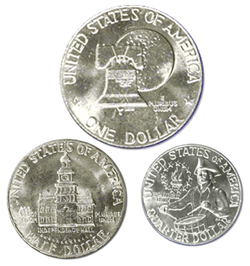|
"Making Cents"
The Signal
Saturday, January 20, 2007
| I |
In 1973, the Treasury Department announced an open contest for designs for three of our coins for the bicentennial of the American Revolution.
The coins would be the quarter, half dollar and the dollar. They would bear the dual dates 1776-1976 and be minted in 1975 as well as 1976 with these dual dates. As a result, no 1975-dated quarters, halves or dollar coins were minted.
The selected design for the quarter was submitted by Jack L. Ahr. The reverse design featured a drummer boy with the uniform of the period and a torch surrounded by 13 stars in the background. This broke tradition of having an eagle on the reverse of our circulating quarters.
The coins were minted at Philadelphia (no mintmark), Denver ("D") and San Francisco ("S," proof coins only). These were minted in the copper-nickel clad composition that had been used since 1965. In addition, some 4 million copper-nickel clad proofs were issued with the "S" mintmark, as well as 7 million 90-percent silver clad pieces for collectors.
In the same contest, the selected design for the half dollar was submitted by Seth G. Huntington. It featured a frontal view of Independence Hall in Philadelphia. As with the quarter, Philadelphia Mint coins and Denver Mint coins were issued for general circulation. Copper-nickel clad "S" mint coins were issued in San Francisco in proof condition for collectors. Some 11 million silver clad pieces were also issued with the "S" mintmark for collectors. Of those, as with the quarters, some 4 million silver clad halves were issued in proof sets.
The Eisenhower dollar also was a part of the Bicentennial series. The reverse design was the creation of Dennis R. Williams. It consisted of the Liberty Bell with the moon in the background. As with the other two coins, it also broke with tradition in not featuring an eagle on the reverse. The 1776-1976 issue came both with no mintmark (Philadelphia) and the "D" mintmark. The "S"-mintmarked copper-nickel clad coins were issued in proof sets. As with the other denominations, silver clad coins were issued for collectors and silver clad proofs were issued in the proof sets of both 1975 and 1976.
In all three cases, an undisclosed number of silver clad pieces were never sold and were melted. The silver clad trio came in three-piece proof sets, while the copper-nickel clad coins were included in the regular proof sets (1975 and 1976) with the other denominations, 1 cent, 5 cents and 10 cents.
Many people who found these coins in circulation have kept them. They have no numismatic value and very little investment potential, since they can be purchased for a shade over face value, except for the silver clad and proof issues.
The mintage figures for the copper-nickel clad coins are in the hundreds of millions. Even the proof issues are high, compared to other dates.
This trio sets the pattern for other circulating commemorative coins such as the 2004 and 2005 Jefferson nickel commemoratives and the current series of 50-state quarters. The upcoming 2007 presidential dollar coin series will be the latest Mint venture into circulating commemorative coinage.
For school children, a set of the three copper-nickel clad coins makes for a nice "show and tell" presentation at modest cost.
Dr. Sol Taylor of Sherman Oaks is president of the Society of Lincoln Cent Collectors and author of The Standard Guide to the Lincoln Cent. Click here for ordering information.
©2007, THE SIGNAL · ALL RIGHTS RESERVED.

![[Most Recent Quotes from www.kitco.com]](http://www.kitconet.com/images/quotes_special.gif)

